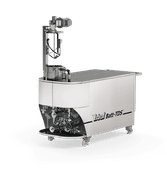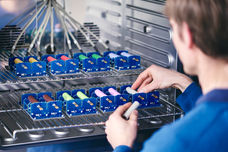Sandia researchers seek ways to make lithium-ion batteries work longer, safer
Batteries could soon replace standard nickel-metal hydride batteries in hybrid vehicles
Advertisement
As part of the Department of Energy-funded FreedomCAR program, Sandia National Laboratories' Power Sources Technology Group is researching ways to make lithium-ion batteries work longer and safer. The research could lead to these batteries being used in new hybrid electric vehicles (HEVs) in the next five to ten years.
"Batteries are a necessary part of hybrid electric-gasoline powered vehicles and someday, when the technology matures, will be part of hybrid electric-hydrogen fuel cell powered vehicles," says Dan Doughty, manager of Sandia's Advanced Power Sources Research and Development Department. "Current hybrid vehicles use nickel-metal hydride batteries, but a safe lithium-ion battery will be a much better option for the hybrids." He notes a lithium-ion battery has four times the energy density of lead-acid batteries and two to three times the energy density of nickel-cadmium and nickel-metal hydride batteries. It also has the potential to be one of the lowest-cost battery systems.
Doughty's department receives about $1.5 million a year from the FreedomCAR program to improve the safety, lengthen the lifetime, and reduce costs of lithium-ion batteries. "We want to develop a battery that has a graceful failure - meaning that if it's damaged, it won't cause other problems," Doughty says. "We have to understand how batteries fail and why they fail." The technical goal is to comprehend mechanisms that lead to poor abuse tolerance, including heat- and gas-generating reactions. Understanding the chemical response to abuse can point the way to better battery materials. But, Doughty says, there is no "magic bullet" for completely stable lithium-ion cells. Work in abuse tolerance is beginning to shed light on mechanisms that control cell response, including effects of the anode and cathode, electrolyte breakdown, and battery additives. The other area of work, accelerated life test, involves developing a method to predict lithium-ion battery life.
"We have two approaches in our research - the empirical model and the mechanistic model," Doughty says. "The empirical model generates life prediction from accelerated degradation test data, while the mechanistic model relates life prediction to changes in battery materials. Our approach provides an independent measure of battery life so we don't have to rely on what battery manufacturers tell us."
Other news from the department science
These products might interest you
Most read news
More news from our other portals
See the theme worlds for related content
Topic World Battery Technology
The topic world Battery Technology combines relevant knowledge in a unique way. Here you will find everything about suppliers and their products, webinars, white papers, catalogs and brochures.

Topic World Battery Technology
The topic world Battery Technology combines relevant knowledge in a unique way. Here you will find everything about suppliers and their products, webinars, white papers, catalogs and brochures.


































































